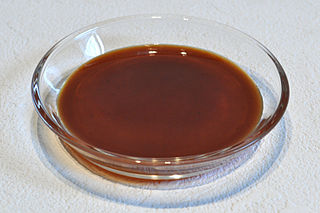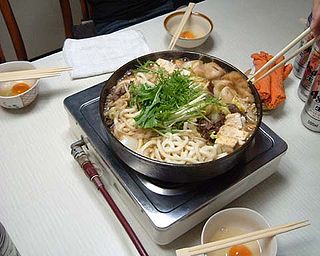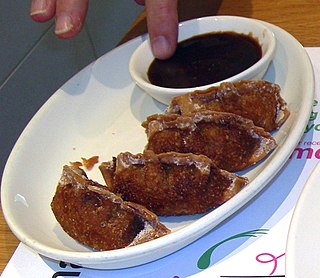
Tomato sauce can refer to many different sauces made primarily from tomatoes, usually to be served as part of a dish, rather than as a condiment. Tomato sauces are common for meat and vegetables, but they are perhaps best known as bases for sauces for Mexican salsas and Italian pasta dishes. Tomatoes have a rich flavor, high water content, soft flesh which breaks down easily, and the right composition to thicken into a sauce when stewed, without the need for thickeners such as roux or masa. All of these qualities make them ideal for simple and appealing sauces.

Vietnamese cuisine encompasses the foods and beverages originated from Vietnam. Meals feature a combination of five fundamental tastes : sweet, salty, bitter, sour, and spicy. The distinctive nature of each dish reflects one or more elements, which are also based around a five-pronged philosophy. Vietnamese recipes use ingredients like lemongrass, ginger, mint, Vietnamese mint, long coriander, Saigon cinnamon, bird's eye chili, lime, and Thai basil leaves. Traditional Vietnamese cooking has often been characterised as using fresh ingredients, not using much dairy or oil, having interesting textures, and making use of herbs and vegetables. The cuisine is also low in sugar and is almost always naturally gluten-free, as many of the dishes are rice-based instead of wheat-based, made with rice noodles, papers and flour. Vietnamese cuisine is strongly influenced not only by the cuisines of neighboring China, Cambodia and Laos, but also by French cuisine due to French colonial rule over the region from 1887 to 1954.

Worcestershire sauce or Worcester sauce is a fermented liquid condiment invented by the pharmacists John Wheeley Lea and William Henry Perrins in the city of Worcester in Worcestershire, England, during the first half of the 19th century. The inventors went on to form the company Lea & Perrins.

Fish sauce is a liquid condiment made from fish or krill that have been coated in salt and fermented for up to two years. It is used as a staple seasoning in East Asian cuisine and Southeast Asian cuisine, particularly Myanmar, Cambodia, Laos, Philippines, Thailand, and Vietnam. Some garum-related fish sauces have been used in the West since the Roman times.

In cooking, a sauce is a liquid, cream, or semi-solid food, served on or used in preparing other foods. Most sauces are not normally consumed by themselves; they add flavor, moisture, and visual appeal to a dish. Sauce is a French word taken from the Latin salsa, meaning salted. Possibly the oldest recorded European sauce is garum, the fish sauce used by the Ancient Romans, while doubanjiang, the Chinese soy bean paste is mentioned in Rites of Zhou in the 3rd century BC.

Nabemono, or simply nabe, is a variety of Japanese hot pot dishes, also known as one pot dishes and "things in a pot".

Teriyaki is a cooking technique in which foods are broiled or grilled with a glaze of soy sauce, mirin, and sugar. Although commonly associated with Japanese cuisine, this cooking technique is also commonly used in other Asian cuisines such as Chinese cuisine, Indonesian cuisine and Thai cuisine.

Sukiyaki is a Japanese dish that is prepared and served in the nabemono style.

Fried rice is a dish of cooked rice that has been stir-fried in a wok or a frying pan and is usually mixed with other ingredients such as eggs, vegetables, seafood, or meat. It is often eaten by itself or as an accompaniment to another dish. Fried rice is a popular component of East Asian, Southeast Asian and certain South Asian cuisines, as well as a staple national dish of Indonesia. As a homemade dish, fried rice is typically made with ingredients left over from other dishes, leading to countless variations. Fried rice first developed during the Sui Dynasty in China.

Hot sauce is a type of condiment, seasoning, or salsa made from chili peppers and other ingredients. Many commercial varieties of mass-produced hot sauce exist.

Peanut sauce, satay sauce, bumbu kacang, sambal kacang, or pecel is an Indonesian sauce made from ground roasted or fried peanuts, widely used in Indonesian cuisine and many other dishes throughout the world.

Mole, meaning 'sauce', is a traditional sauce and marinade originally used in Mexican cuisine. In contemporary Mexico the term is used for a number of sauces, some quite dissimilar, including mole amarillo or amarillito, mole chichilo, mole colorado or coloradito, mole manchamantel or manchamanteles, mole negro, mole rojo, mole verde, mole poblano, mole almendrado, mole michoacano, mole prieto, mole ranchero, mole tamaulipeco, mole xiqueno, mole pipián, mole rosa, mole blanco, chimole, guacamole and huaxmole.

Bolognese sauce, known in Italian as ragù alla bolognese or ragù bolognese, is a meat-based sauce in Italian cuisine, typical of the city of Bologna. It is customarily used to dress tagliatelle al ragù and to prepare lasagne alla bolognese.

Nam phrik is a type of Thai spicy chili sauce typical of Thai cuisine. Usual ingredients for nam phrik type sauces are fresh or dry chilies, garlic, shallots, lime juice and often some kind of fish or shrimp paste. In the traditional way of preparing these sauces, the ingredients are pounded together using a mortar and pestle, with either salt or fish sauce added to taste.

Mushroom ketchup is a style of ketchup that is prepared with mushrooms as its primary ingredient. Originally, ketchup in the United Kingdom was prepared with mushrooms as a primary ingredient, instead of tomato, the main ingredient in most modern preparations of ketchup. Historical preparations involved packing whole mushrooms into containers with salt. It is used as a condiment and may be used as an ingredient in the preparation of other sauces and other condiments. Several brands of mushroom ketchup were produced and marketed in the United Kingdom, some of which were exported to the United States, and some are still manufactured as a commercial product.

Chinese bhel is a fast food and street food item in India and is considered a part of Indo-Chinese cuisine. It is a variant of chop suey and bhelpuri. It is popular in Mumbai.

Hot pot or hotpot, also known as steamboat, is a dish whereby a heat source placed on the dining table keeps a pot of soup stock simmering, and a variety of Chinese foodstuffs and ingredients are served beside the pot for the diners to put into the hot stock.

Hoisin sauce is a thick, fragrant sauce commonly used in Cantonese cuisine as a glaze for meat, an addition to stir fry, or as dipping sauce. It is dark-coloured, sweet and salty. Although regional variants exist, hoisin sauce usually includes soybeans, fennel, red chili peppers, and garlic. Vinegar, five-spice powder, and sugar are also commonly added.

















